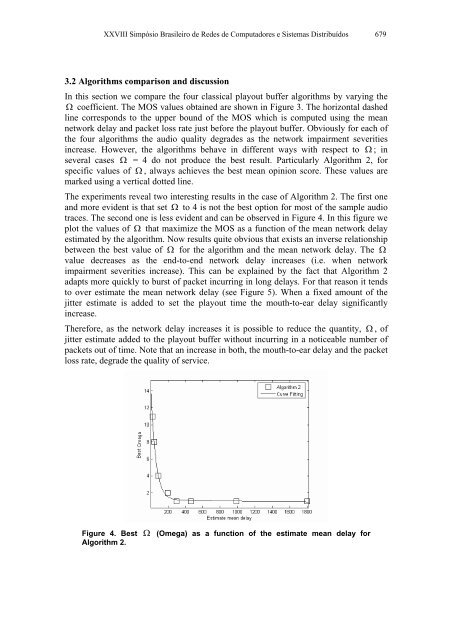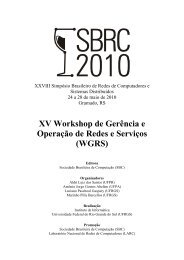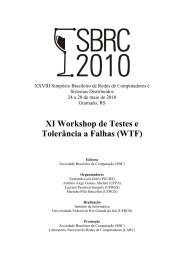Classical Playout Buffer Algorithm Revisited
Classical Playout Buffer Algorithm Revisited
Classical Playout Buffer Algorithm Revisited
Create successful ePaper yourself
Turn your PDF publications into a flip-book with our unique Google optimized e-Paper software.
XXVIII Simpósio Brasileiro de Redes de Computadores e Sistemas Distribuídos 679<br />
3.2 <strong>Algorithm</strong>s comparison and discussion<br />
In this section we compare the four classical playout buffer algorithms by varying the<br />
Ω coefficient. The MOS values obtained are shown in Figure 3. The horizontal dashed<br />
line corresponds to the upper bound of the MOS which is computed using the mean<br />
network delay and packet loss rate just before the playout buffer. Obviously for each of<br />
the four algorithms the audio quality degrades as the network impairment severities<br />
increase. However, the algorithms behave in different ways with respect to Ω ; in<br />
several cases Ω = 4 do not produce the best result. Particularly <strong>Algorithm</strong> 2, for<br />
specific values of Ω , always achieves the best mean opinion score. These values are<br />
marked using a vertical dotted line.<br />
The experiments reveal two interesting results in the case of <strong>Algorithm</strong> 2. The first one<br />
and more evident is that set Ω to 4 is not the best option for most of the sample audio<br />
traces. The second one is less evident and can be observed in Figure 4. In this figure we<br />
plot the values of Ω that maximize the MOS as a function of the mean network delay<br />
estimated by the algorithm. Now results quite obvious that exists an inverse relationship<br />
between the best value of Ω for the algorithm and the mean network delay. The Ω<br />
value decreases as the end-to-end network delay increases (i.e. when network<br />
impairment severities increase). This can be explained by the fact that <strong>Algorithm</strong> 2<br />
adapts more quickly to burst of packet incurring in long delays. For that reason it tends<br />
to over estimate the mean network delay (see Figure 5). When a fixed amount of the<br />
jitter estimate is added to set the playout time the mouth-to-ear delay significantly<br />
increase.<br />
Therefore, as the network delay increases it is possible to reduce the quantity, Ω , of<br />
jitter estimate added to the playout buffer without incurring in a noticeable number of<br />
packets out of time. Note that an increase in both, the mouth-to-ear delay and the packet<br />
loss rate, degrade the quality of service.<br />
Figure 4. Best Ω (Omega) as a function of the estimate mean delay for<br />
<strong>Algorithm</strong> 2.







